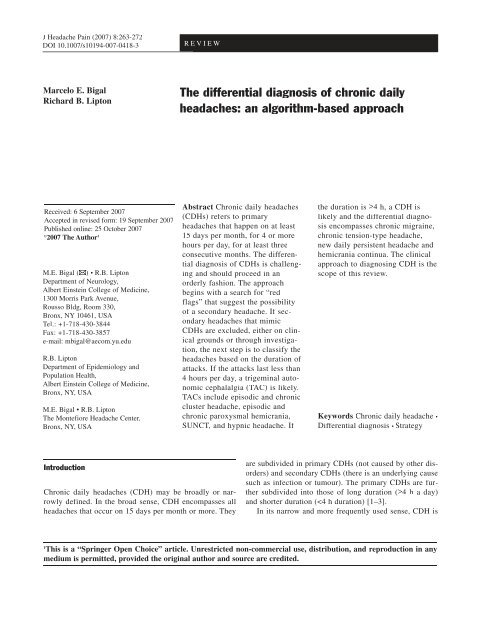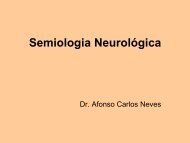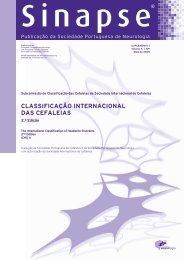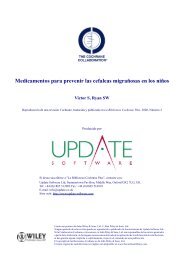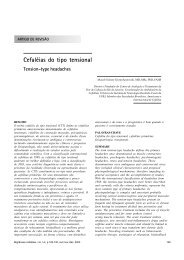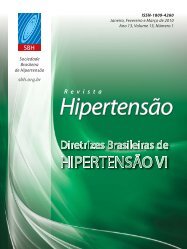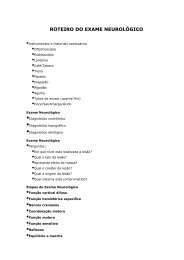The differential diagnosis of chronic daily headaches: an ... - marchioli
The differential diagnosis of chronic daily headaches: an ... - marchioli
The differential diagnosis of chronic daily headaches: an ... - marchioli
Create successful ePaper yourself
Turn your PDF publications into a flip-book with our unique Google optimized e-Paper software.
J Headache Pain (2007) 8:263-272<br />
DOI 10.1007/s10194-007-0418-3<br />
REVIEW<br />
Marcelo E. Bigal<br />
Richard B. Lipton<br />
<strong>The</strong> <strong>differential</strong> <strong>diagnosis</strong> <strong>of</strong> <strong>chronic</strong> <strong>daily</strong><br />
<strong>headaches</strong>: <strong>an</strong> algorithm-based approach<br />
Received: 6 September 2007<br />
Accepted in revised form: 19 September 2007<br />
Published online: 25 October 2007<br />
©<br />
2007 <strong>The</strong> Author 1<br />
M.E. Bigal () • R.B. Lipton<br />
Department <strong>of</strong> Neurology,<br />
Albert Einstein College <strong>of</strong> Medicine,<br />
1300 Morris Park Avenue,<br />
Rousso Bldg, Room 330,<br />
Bronx, NY 10461, USA<br />
Tel.: +1-718-430-3844<br />
Fax: +1-718-430-3857<br />
e-mail: mbigal@aecom.yu.edu<br />
R.B. Lipton<br />
Department <strong>of</strong> Epidemiology <strong>an</strong>d<br />
Population Health,<br />
Albert Einstein College <strong>of</strong> Medicine,<br />
Bronx, NY, USA<br />
M.E. Bigal • R.B. Lipton<br />
<strong>The</strong> Montefiore Headache Center,<br />
Bronx, NY, USA<br />
Abstract Chronic <strong>daily</strong> <strong>headaches</strong><br />
(CDHs) refers to primary<br />
<strong>headaches</strong> that happen on at least<br />
15 days per month, for 4 or more<br />
hours per day, for at least three<br />
consecutive months. <strong>The</strong> <strong>differential</strong><br />
<strong>diagnosis</strong> <strong>of</strong> CDHs is challenging<br />
<strong>an</strong>d should proceed in <strong>an</strong><br />
orderly fashion. <strong>The</strong> approach<br />
begins with a search for “red<br />
flags” that suggest the possibility<br />
<strong>of</strong> a secondary headache. If secondary<br />
<strong>headaches</strong> that mimic<br />
CDHs are excluded, either on clinical<br />
grounds or through investigation,<br />
the next step is to classify the<br />
<strong>headaches</strong> based on the duration <strong>of</strong><br />
attacks. If the attacks last less th<strong>an</strong><br />
4 hours per day, a trigeminal autonomic<br />
cephalalgia (TAC) is likely.<br />
TACs include episodic <strong>an</strong>d <strong>chronic</strong><br />
cluster headache, episodic <strong>an</strong>d<br />
<strong>chronic</strong> paroxysmal hemicr<strong>an</strong>ia,<br />
SUNCT, <strong>an</strong>d hypnic headache. If<br />
the duration is ≥4 h, a CDH is<br />
likely <strong>an</strong>d the <strong>differential</strong> <strong>diagnosis</strong><br />
encompasses <strong>chronic</strong> migraine,<br />
<strong>chronic</strong> tension-type headache,<br />
new <strong>daily</strong> persistent headache <strong>an</strong>d<br />
hemicr<strong>an</strong>ia continua. <strong>The</strong> clinical<br />
approach to diagnosing CDH is the<br />
scope <strong>of</strong> this review.<br />
Keywords Chronic <strong>daily</strong> headache •<br />
Differential <strong>diagnosis</strong> • Strategy<br />
Introduction<br />
Chronic <strong>daily</strong> <strong>headaches</strong> (CDH) may be broadly or narrowly<br />
defined. In the broad sense, CDH encompasses all<br />
<strong>headaches</strong> that occur on 15 days per month or more. <strong>The</strong>y<br />
are subdivided in primary CDHs (not caused by other disorders)<br />
<strong>an</strong>d secondary CDHs (there is <strong>an</strong> underlying cause<br />
such as infection or tumour). <strong>The</strong> primary CDHs are further<br />
subdivided into those <strong>of</strong> long duration (≥4 h a day)<br />
<strong>an</strong>d shorter duration (
264<br />
used to refer exclusively to “primary CDH <strong>of</strong> long duration”,<br />
a clinical syndrome defined by <strong>headaches</strong> that occur<br />
for ≥4 h a day on ≥15 days a month over >3 months in<br />
individuals without <strong>an</strong> underlying cause [1]. Unless otherwise<br />
indicated, in this paper, CDH refers to primary CDHs<br />
<strong>of</strong> long duration.<br />
CDH is the third most common primary headache in<br />
the population, with <strong>an</strong> overall prevalence r<strong>an</strong>ging from<br />
4% to 5% [4, 5]. Because <strong>of</strong> their frequency, severity <strong>an</strong>d<br />
duration, CDHs are extraordinarily burdensome to individuals<br />
<strong>an</strong>d society. Furthermore, CDH is the most common<br />
reason for consultation in headache clinics.<br />
<strong>The</strong> Silberstein <strong>an</strong>d Lipton (S-L) criteria for CDH <strong>an</strong>d its<br />
subtypes have been widely used <strong>an</strong>d are well accepted [1].<br />
According to these criteria, CDH is divided into four groups:<br />
<strong>chronic</strong> or tr<strong>an</strong>sformed migraine (CM/TM), <strong>chronic</strong> tensiontype<br />
headache (CTTH), new <strong>daily</strong> persistent headache<br />
(NDPH) <strong>an</strong>d hemicr<strong>an</strong>ia continua (HC), <strong>an</strong>d subclassified<br />
into subtypes with medication overuse or without medication<br />
overuse, incorporating the concept that medication overuse<br />
is <strong>of</strong>ten associated with the onset <strong>of</strong> CDH.<br />
<strong>The</strong> <strong>differential</strong> <strong>diagnosis</strong> <strong>of</strong> CDHs is challenging <strong>an</strong>d<br />
should proceed in <strong>an</strong> orderly fashion. Crucial elements<br />
include a thorough history, supplemented by general medical<br />
<strong>an</strong>d neurological examinations, as well as laboratory<br />
testing <strong>an</strong>d neuroimaging in selected patients. Herein we<br />
discuss the strategy to diagnose CDHs <strong>an</strong>d their differen-<br />
tial <strong>diagnosis</strong>. We<br />
emphasise that this strategy reflects the<br />
authors’ personal view <strong>of</strong> CDHs, as well as our personal<br />
diagnostic experience. Furthermore, the diagnostic algorithms<br />
presented herein have not been validated.<br />
First step: distinguishing primary from secondary CDH<br />
An import<strong>an</strong>t first step in headache <strong>diagnosis</strong> is to distinguish<br />
primary from secondary CDH. <strong>The</strong> detailed strategies<br />
to identify or exclude secondary <strong>headaches</strong> are<br />
beyond the scope <strong>of</strong> this paper. In brief, the approach<br />
begins with a search for “red flags” that suggest the possibility<br />
<strong>of</strong> a secondary headache (Fig. 1). Once these features<br />
are identified, the physici<strong>an</strong> must conduct the appropriate<br />
work-up to identify or exclude the conditions suggested<br />
by the red flag (Table 1). Once secondary headache<br />
is excluded by history, physical <strong>an</strong>d neurological examination<br />
<strong>an</strong>d/or appropriate testing, the next step is to diagnose<br />
the primary headache disorder [6].<br />
M<strong>an</strong>y patients with red flags do not have secondary<br />
headache disorders. Nonetheless, when red flags are present,<br />
they <strong>of</strong>ten merit investigation. Red flags include: (1)<br />
sudden onset <strong>of</strong> a severe headache; (2) a worsening pattern<br />
<strong>of</strong> a preexisting headache in the absence <strong>of</strong> obvious predisposing<br />
factors (e.g. medication overuse, depression); (3)<br />
headache with c<strong>an</strong>cer, HIV or other systemic illness (fever,<br />
neck stiffness, cut<strong>an</strong>eous rash); (4) headache associated<br />
Fig. 1 Algorithm for headache <strong>diagnosis</strong>. Modified from [25]
265<br />
with focal neurologic signs other th<strong>an</strong> typical visual or<br />
sensory aura; (5) headache in a patient with papilloedema;<br />
(6) moderate or severe headache triggered by cough, exertion,<br />
orgasm or Valsalva; <strong>an</strong>d (7) new onset <strong>of</strong> a headache<br />
during pregn<strong>an</strong>cy or post-partum.<br />
Other less common secondary causes <strong>of</strong> intractable<br />
headache that may lead to CDH are summarised in Table<br />
2. Detection <strong>of</strong> m<strong>an</strong>y <strong>of</strong> these disorders requires a systematic<br />
approach to the headache history <strong>an</strong>d physical examination<br />
as well as a high index <strong>of</strong> suspicion. We will highlight<br />
some <strong>of</strong> these critical issues. For a review on this<br />
topic, the reader is referred to [7].<br />
Red flags triggered by the temporal pr<strong>of</strong>ile <strong>of</strong> headache<br />
<strong>The</strong> temporal pr<strong>of</strong>ile <strong>of</strong> the headache, <strong>an</strong>d its nature <strong>an</strong>d<br />
the circumst<strong>an</strong>ces <strong>of</strong> its onset are crucial for <strong>diagnosis</strong>. <strong>The</strong><br />
temporal pr<strong>of</strong>ile <strong>of</strong> a headache c<strong>an</strong> provide import<strong>an</strong>t clues<br />
to its aetiology. A few examples are listed below:<br />
• A rapid-onset headache may suggest a subarachnoid haemorrhage,<br />
pituitary apoplexy [8] or other intracr<strong>an</strong>ial catastrophes<br />
[9]. <strong>The</strong>se disorders rarely cause CDH, but c<strong>an</strong> result in<br />
intractability <strong>of</strong> <strong>an</strong> ongoing headache attack.<br />
Table 1 Red flags in the <strong>diagnosis</strong> <strong>of</strong> headache. Modified from [6]<br />
Red flag Consider Possible investigation(s)<br />
Sudden-onset headache Subarachnoid haemorrhage, bleed into a mass Neuroimaging, lumbar puncture<br />
or AVM, mass lesion (especially posterior fossa) (after neuroimaging evaluation)<br />
Worsening-pattern headache Mass lesion, subdural haematoma, medication overuse Neuroimaging<br />
Headache with c<strong>an</strong>cer, HIV or other Meningitis, encephalitis, Lyme disease, systemic Neuroimaging, lumbar puncture, biopsy,<br />
systemic illness (fever, neck stiffness, infection, collagen vascular disease, arteritis blood tests<br />
cut<strong>an</strong>eous rash)<br />
Focal neurologic signs, or symptoms Mass lesion, AVM, collagen vascular disease Neuroimaging, collagen vascular<br />
other th<strong>an</strong> typical visual or sensory aura<br />
evaluation<br />
Papilloedema Mass lesion, pseudotumour, encephalitis, meningitis Neuroimaging, lumbar puncture<br />
(after neuroimaging evaluation)<br />
Triggered by cough, exertion or Valsalva Subarachnoid haemorrhage, mass lesion Neuroimaging, consider lumbar<br />
puncture<br />
Headache during pregn<strong>an</strong>cy or post-partum Cortical vein/cr<strong>an</strong>ial sinus thrombosis, carotid Neuroimaging<br />
dissection, pituitary apoplexy<br />
Table 2 Secondary <strong>headaches</strong> that mimic <strong>chronic</strong> benign headache syndromes<br />
Headache associated with vascular disorders<br />
Cerebrovascular disease including carotid artery dissection <strong>an</strong>d arteriovenous malformation<br />
Arteritis including gi<strong>an</strong>t cell arteritis<br />
Headache associated with non-vascular intracr<strong>an</strong>ial disorders<br />
Low CSF pressure syndrome (spont<strong>an</strong>eous or post-traumatic CSF “leak”)<br />
High CSF pressure without papilloedema<br />
Intracr<strong>an</strong>ial: Lyme disease, hum<strong>an</strong> immunodeficiency virus, encephalitis, fungal meningitis, etc.<br />
Headache associated with subst<strong>an</strong>ces or their withdrawal<br />
Overuse <strong>of</strong> acute headache medications (rebound or toxic drug overuse syndromes)<br />
Headache associated with cr<strong>an</strong>ium, neck, eyes, ears, nose, sinuses, teeth, mouth or other facial or cr<strong>an</strong>ial structures<br />
Otolaryngologic disease, including <strong>chronic</strong> sphenoid sinusitis (or other sinus disease)<br />
Nasopharyngeal disorders, including carcinoma<br />
Disorders <strong>of</strong> the trigeminal nerve, including dental <strong>an</strong>d oral disease, jaw pathology<br />
Subacute <strong>an</strong>gle closure glaucoma, optic neuritis <strong>an</strong>d other ocular disorders<br />
Occipitocervical disease, including Arnold-Chiari Malformation Type I; upper cervical joint, root or nerve (neuralgic) syndromes<br />
Headache associated with non-cephalic infection, metabolic or systemic disturb<strong>an</strong>ces<br />
Hepatitis, renal disease, B 12 deficiency, <strong>an</strong>aemia, exposure to carbon monoxide <strong>an</strong>d other toxins<br />
Hormonal disturb<strong>an</strong>ces/endocrinologic disease (oestrogen, thyroid disease, hyperprolactinaemia, etc.)<br />
Vasculitis/rheumatic/connective tissue disorders<br />
Miscell<strong>an</strong>ea<br />
Mediastinal <strong>an</strong>d thoracic processes including <strong>an</strong>gina, mass lesions, superior vena cava syndrome
266<br />
• Sphenoid sinusitis may cause NDPH <strong>an</strong>d may be missed<br />
radiologically unless appropriate studies are performed [10].<br />
• Headaches that start after age 55 suggest <strong>an</strong> org<strong>an</strong>ic disorder<br />
for CDH, such as a mass lesion or gi<strong>an</strong>t cell arteritis<br />
[11]. Gi<strong>an</strong>t cell arteritis is <strong>of</strong>ten under-diagnosed, <strong>an</strong>d is <strong>an</strong><br />
import<strong>an</strong>t cause <strong>of</strong> preventable blindness in the elderly.<br />
Red flags triggered by concurrent events or provoking<br />
activity<br />
Concurrent events <strong>an</strong>d headache triggers may give clues to<br />
<strong>diagnosis</strong>, <strong>an</strong>d some <strong>of</strong> them are listed below:<br />
• Chronic <strong>headaches</strong> (NDPH) that occur in the peripartum<br />
period may be due to dural sinus thrombosis [12].<br />
• Orthostatic CDH suggests a low CSF pressure headache<br />
(from a spont<strong>an</strong>eous CSF leak, a previous lumbar puncture,<br />
or <strong>an</strong> epidural block) [13].<br />
• CDH exacerbated by straining, coughing or sneezing<br />
suggests a hindbrain malformation, occipitocervical junction<br />
disorder or increased intracr<strong>an</strong>ial pressure [14].<br />
• CDH that is worse in the morning in the absence <strong>of</strong> medication<br />
overuse, that may suggest raised intracr<strong>an</strong>ial pressure.<br />
CDH with medication overuse is <strong>of</strong>ten worse in the<br />
morning.<br />
• In contrast, subjects with CDH that is better in the morning<br />
<strong>an</strong>d worse at night that may suggest low CSF volume<br />
headache [13].<br />
• Similarly, CDHs that are worse on awakening sometimes<br />
occur with obstructive sleep apnoea [13].<br />
• Increasing pain while upright, <strong>an</strong>d neck pain <strong>an</strong>d<br />
headache provoked by flexion or extension <strong>of</strong> the neck<br />
might suggest <strong>an</strong> occipitocervical junction disorder or a<br />
systemic medical illness [15–17].<br />
• Search for opportunistic infections, including toxoplasmosis<br />
<strong>an</strong>d cryptococcal meningitis, in patients who may<br />
have HIV infection or HIV risk factors [18].<br />
• A previous mild to moderate head or neck injury is frequently<br />
overlooked in the st<strong>an</strong>dard history, despite the fact<br />
that it c<strong>an</strong> render <strong>an</strong> individual refractory to st<strong>an</strong>dard<br />
headache treatments [19]. A <strong>diagnosis</strong> <strong>of</strong> post-traumatic<br />
headache may lead to additional treatment including trigger<br />
point injections <strong>an</strong>d facet joint <strong>an</strong>d cervical nerve<br />
blocks.<br />
• <strong>The</strong> history <strong>of</strong>ten neglects recent dental procedures. Root<br />
c<strong>an</strong>als, tooth extractions or bite disturb<strong>an</strong>ces may provoke<br />
or be associated with the development <strong>of</strong> CDH due to brain<br />
abscess [20, 21].<br />
• Consider ocular disturb<strong>an</strong>ces, such as subacute <strong>an</strong>gle closure<br />
glaucoma, or infection, if the CDH is worse in the<br />
periorbital region [22].<br />
• Nasal blockage, drainage, pus or pressure may suggest<br />
sinus disease [23]. Nasopharyngeal carcinoma c<strong>an</strong> produce<br />
<strong>chronic</strong> head <strong>an</strong>d face pain <strong>an</strong>d c<strong>an</strong> be identified by<br />
detailed, expert examination <strong>of</strong> the nasopharynx or neuroimaging<br />
[24].<br />
In the absence <strong>of</strong> secondary CDH, the clinici<strong>an</strong> proceeds<br />
to diagnose a primary CDH disorder. If the headache is atypical<br />
or difficult to classify, the possibility <strong>of</strong> secondary<br />
headache should be reconsidered, although the modifying<br />
effect <strong>of</strong> <strong>an</strong>y treatment being taken should be kept in mind.<br />
Additionally, lack <strong>of</strong> response to appropriate treatment given<br />
for enough time may also be considered a red flag.<br />
Second step: classifying primary CDH based on duration<br />
<strong>an</strong>d frequency (Fig. 2)<br />
Basically, in a patient where we excluded, either by clini-<br />
Fig. 2 Algorithm for classifying primary <strong>headaches</strong> based on frequency <strong>an</strong>d duration
267<br />
cal history or by appropriate investigation, secondary<br />
headache syndromes, the next step is to divide the primary<br />
<strong>headaches</strong> based on average monthly frequency <strong>of</strong> the<br />
attacks. Doing so, we divide patients into those <strong>of</strong> low-tomoderate<br />
frequency (
268<br />
th<strong>an</strong> not. It does not occur outside sleep. Hypnic headache<br />
is usually bilateral (though unilaterality does not exclude<br />
the <strong>diagnosis</strong>) <strong>an</strong>d usually mild to moderate, very different<br />
from the unilateral orbital or periorbital knife-like intense<br />
pain <strong>of</strong> cluster headache. Autonomic features are absent<br />
[31, 32].<br />
Chronic <strong>daily</strong> <strong>headaches</strong> <strong>of</strong> long duration (Fig. 4)<br />
<strong>The</strong>re are four CDHs <strong>of</strong> long duration, which are discussed<br />
here. According to the S-L criteria, all subtypes are subdivided<br />
into with or without medication overuse. According<br />
to the Second Edition <strong>of</strong> the International Classification <strong>of</strong><br />
the Headache Disorders (ICHD-2), a CDH with medication<br />
overuse should be classified as medication overuse<br />
headache (MOH) regardless <strong>of</strong> the phenotype. <strong>The</strong>refore,<br />
in the following section we first describe the four subtypes<br />
<strong>of</strong> the CDH <strong>an</strong>d then separately describe MOH.<br />
Chronic or tr<strong>an</strong>sformed migraine<br />
<strong>The</strong> terms <strong>chronic</strong> migraine (CM) <strong>an</strong>d tr<strong>an</strong>sformed<br />
migraine (TM) are frequently used interch<strong>an</strong>geably,<br />
although since the publication <strong>of</strong> ICHD-2 this is no longer<br />
appropriate [33]. Although the two are related, they are<br />
different clinical entities with specific definitions.<br />
Patients with TM/CM typically have a past history <strong>of</strong><br />
migraine. It is more frequent in women with a past history<br />
<strong>of</strong> migraine without aura. Subjects usually report a process<br />
<strong>of</strong> tr<strong>an</strong>sformation over months or years, <strong>an</strong>d as headache<br />
increases in frequency, associated symptoms become less<br />
severe <strong>an</strong>d frequent. <strong>The</strong> process <strong>of</strong> tr<strong>an</strong>sformation frequently<br />
ends in a pattern <strong>of</strong> <strong>daily</strong> or nearly <strong>daily</strong> headache<br />
that resembles <strong>chronic</strong> tension-type headache, with some<br />
attacks <strong>of</strong> full-migraine superimposed [1–3, 34, 35]. In the<br />
clinical setting, migraine tr<strong>an</strong>sformation most <strong>of</strong>ten is<br />
related to acute medication overuse, but tr<strong>an</strong>sformation<br />
may occur without overuse. In the more general population,<br />
most cases <strong>of</strong> TM are not related to medication<br />
overuse [36]. Multiple risk factors may be involved in<br />
these cases.<br />
<strong>The</strong> S-L criteria identify three potential links to<br />
migraine in TM: (A) a prior history <strong>of</strong> ICHD defined<br />
migraine; (B) a period <strong>of</strong> escalating headache frequency;<br />
<strong>an</strong>d (C) concurrent superimposed attacks <strong>of</strong> migraine that<br />
fulfil the IHS criteria. TM is subdivided into with or without<br />
medication overuse. If frequent migraine develops de<br />
novo in a previously headache-free subject, the <strong>diagnosis</strong><br />
is new <strong>daily</strong> persistent headache according to S-L criteria.<br />
<strong>The</strong> ICHD-2 criteria for CM initially required 15 or more<br />
days <strong>of</strong> migraine per month [33], but these criteria were<br />
shown to be too restrictive for clinical practice <strong>an</strong>d research<br />
Fig. 4 CDHs <strong>of</strong> long duration
269<br />
[37–41]. As a consequence, the ICHD-2 criteria for CM<br />
(ICHD-2R) were recently revised in the Appendix <strong>of</strong> the<br />
classification (Table 3) [42]. CM-R is now defined by CDH<br />
plus 8 or more days <strong>of</strong> migraine as evidenced by <strong>headaches</strong><br />
that meet ICHD-2 criteria for migraine without aura or<br />
headache with response to acute treatment with a migrainespecific<br />
medication (tript<strong>an</strong> or ergotamine compound). As<br />
previously stated, if subjects are overusing acute medication<br />
they should be classified as having MOH [42, 44].<br />
A recent study compared the criteria for CM-R <strong>an</strong>d TM<br />
in a headache specialty clinic. Of 158 patients with TM, just<br />
5.6% met the old ICHD-2 criteria for CM. According to the<br />
ICHD-2R, a total <strong>of</strong> 92.4% met the revised criteria for CM<br />
(p<br />
4 h per day (if untreated) Headache on ≥15 days/month for >3 months.<br />
C. At least one <strong>of</strong> the following: Occurring in a patient with at least 5 prior migraine attacks.<br />
1. History <strong>of</strong> episodic migraine meeting <strong>an</strong>y IHS criteria 1.1–1.6 On ≥8 days per month, for at least three months, headache fills<br />
2. History <strong>of</strong> increasing headache frequency with decreasing criteria C1 <strong>an</strong>d C2<br />
severity <strong>of</strong> migrainous features over at least 3 months<br />
3. Headache at some time meets IHS criteria for migraine 1.<br />
1.1–1.6 other th<strong>an</strong> duration Unilateral<br />
Throbbing<br />
Moderate or severe<br />
D. Does not meet criteria for new <strong>daily</strong> persistent headache (4.7) Aggravated by physical activity<br />
or hemicr<strong>an</strong>ia continua (4.8)<br />
Nausea <strong>an</strong>d/or vomiting<br />
Photophobia <strong>an</strong>d phonophobia<br />
2. Tr<br />
eated or relieved with tript<strong>an</strong>s or ergotamine compounds.<br />
D. No medication overuse <strong>an</strong>d not attributable to <strong>an</strong>other causative<br />
disorder.<br />
IHS, International Headache Society
270<br />
most headache days fill criteria for migraine, <strong>an</strong>d as disease<br />
evolves, the headache attacks become less typical, has<br />
also been supported by <strong>an</strong> adolescent study, where those<br />
with recent-onset CDH were much more likely to have 15<br />
or more migraine days per month (74.5% vs. 25.8%,<br />
p3 months<br />
8.2 Tript<strong>an</strong> overuse headache Tript<strong>an</strong> intake (<strong>an</strong>y formulation) on ≥10 days per month on a regular basis<br />
for >3 months<br />
8.3 Analgesic overuse headache Intake <strong>of</strong> simple <strong>an</strong>algesics on ≥15 days per month on a regular basis<br />
for >3 months<br />
8.4 Opioid overuse headache Opioid intake on ≥10 days per month on a regular basis for >3 months<br />
8.5 Combination <strong>an</strong>algesic overuse headache Intake <strong>of</strong> combination <strong>an</strong>algesic medications on ≥10 days per month<br />
on a regular basis for >3 months<br />
8.6 MOH attributed to combination Intake <strong>of</strong> <strong>an</strong>y combination <strong>of</strong> ergotamine, tript<strong>an</strong>s, <strong>an</strong>algesics, <strong>an</strong>d/or<br />
<strong>of</strong> acute medications<br />
opioids on ≥10 days per month on a regular basis for >3 months<br />
without overuse <strong>of</strong> <strong>an</strong>y single class<br />
8.7 Headache attributed to other Regular overuse for >3 months <strong>of</strong> a medication other th<strong>an</strong> those<br />
medication overuse<br />
described above<br />
8.8 Probable MOH Overused medication has not yet been withdrawn or medication overuse<br />
has ceased within the last 2 months but headache has not so far resolved<br />
or has reverted to its previous pattern
271<br />
Hemicr<strong>an</strong>ia continua<br />
HC is probably the most frequently unrecognised primary<br />
headache. HC is a <strong>chronic</strong>, unilateral pain, commonly mistaken<br />
for TM [53, 54]. Both disorders are characterised by<br />
<strong>chronic</strong> unilateral pain with superimposed painful exacerbations.<br />
In HC, the painful exacerbations are <strong>of</strong>ten associated<br />
with ipsilateral autonomic features such as conjunctival<br />
injection, lacrimation <strong>an</strong>d ptosis. In TM, exacerbations are<br />
more typically accomp<strong>an</strong>ied by nausea, photophobia <strong>an</strong>d<br />
phonophobia. In addition, patients with HC usually do not<br />
have <strong>an</strong>tecedent history <strong>of</strong> episodic migraine. In TM, attacks<br />
increase in frequency over time. If the <strong>headaches</strong> are longst<strong>an</strong>ding,<br />
the patient may not remember how they beg<strong>an</strong>.<br />
Though pain fluctuates in HC, it does not usually have the<br />
morning <strong>an</strong>d end-<strong>of</strong>-dosing-interval pattern <strong>of</strong> exacerbations<br />
typical <strong>of</strong> TM. It is advisable to <strong>of</strong>fer to patients with unilateral<br />
CDH a therapeutic trial with indomethacin prior to other<br />
intervention (doses <strong>of</strong> up to 225 mg/day for three to four<br />
days).<br />
Medication overuse headache<br />
<strong>The</strong> ICHD-II classifies MOH under Chapter 8 (headache<br />
attributed to a subst<strong>an</strong>ce or its withdrawal), under the topic<br />
8.2 (MOH). MOH is subdivided into seven groups, plus <strong>an</strong><br />
additional topic for probable MOH [42]. <strong>The</strong> diagnostic criteria<br />
<strong>an</strong>d the critical amount <strong>of</strong> consumption <strong>of</strong> medication<br />
are displayed in Table 4. According to the ICHD-II, a <strong>diagnosis</strong><br />
<strong>of</strong> MOH is basically established when two situations<br />
are fulfilled: 1. <strong>The</strong> consumption <strong>of</strong> acute medication is<br />
beyond a critical dose; 2. <strong>The</strong>re is a CDH.<br />
Although the traditional criteria required demonstration<br />
<strong>of</strong> improvement after detoxification, the revised criteria for<br />
MOH do not. It just requires a CDH <strong>an</strong>d overuse <strong>of</strong> medication.<br />
Furthermore, the ICHD-II does not suggest that subsidiary<br />
investigation is required in all cases but requires that,<br />
at least clinically, the provider exclude secondary disorders<br />
other th<strong>an</strong> medication overuse.<br />
Conclusions<br />
<strong>The</strong> <strong>differential</strong> <strong>diagnosis</strong> <strong>of</strong> CDH is challenging <strong>an</strong>d<br />
requires a systematic approach. Herein we presented <strong>an</strong> algorithm-based<br />
approach to the <strong>differential</strong> <strong>diagnosis</strong> <strong>of</strong> the<br />
CDHs, which should help physici<strong>an</strong>s interested in headache<br />
to move forward quickly <strong>an</strong>d safely when assessing patients<br />
with <strong>daily</strong> or almost <strong>daily</strong> <strong>headaches</strong>.<br />
References<br />
1. Silberstein SD, Lipton RB, Sliwinski<br />
M (1996) Classification <strong>of</strong> <strong>daily</strong> <strong>an</strong>d<br />
near-<strong>daily</strong> <strong>headaches</strong>: field trial <strong>of</strong><br />
revised IHS criteria. Neurology<br />
47:871–875<br />
2. Spierings EL, R<strong>an</strong>ke AH, Schroevers<br />
M, Honkoop PC (2000) Chronic <strong>daily</strong><br />
headache: a time perspective.<br />
Headache 40:306–310<br />
3. Welch KM, Goadsby PJ (2002)<br />
Chronic <strong>daily</strong> headache: nosology <strong>an</strong>d<br />
pathophysiology. Curr Opin Neurol<br />
15:287–295<br />
4. Scher AI, Stewart WF, Liberm<strong>an</strong> J,<br />
Lipton RB (1998) Prevalence <strong>of</strong> frequent<br />
headache in a population sample.<br />
Headache 38:497–506<br />
5. Castillo J, Muñoz P, Guitera V, Pascual<br />
J (1999) Epidemiology <strong>of</strong> <strong>chronic</strong> <strong>daily</strong><br />
headache in the general population.<br />
Headache 39:190–196<br />
6. Ev<strong>an</strong>s R, Purdy A (2006) Identification<br />
or exclusion <strong>of</strong> secondary <strong>headaches</strong>.<br />
In: Lipton RB, Bigal ME (eds)<br />
Migraine <strong>an</strong>d other headache disorders.<br />
Informa Healthcare, New York, pp<br />
131–144<br />
7. Lipton RB, Silberstein SD, Saper JR et<br />
al (2003) Why headache treatment<br />
fails. Neurology 60:1064–1070<br />
8. Dodick DW, Wijdicks EF (1998)<br />
Pituitary apoplexy presenting as a<br />
thunderclap headache. Neurology<br />
50:510–511<br />
9. Forsyth PA, Posner JB (1993)<br />
Headaches in patients with brain<br />
tumors: a study <strong>of</strong> 111 patients.<br />
Neurology 43:1678–1683<br />
10. Lawson W, Reino AJ (1997) Isolated<br />
sphenoid sinus disease: <strong>an</strong> <strong>an</strong>alysis <strong>of</strong><br />
132 cases. Laryngoscope<br />
107:1590–1595<br />
11. Edmeads J (1997) Headaches in older<br />
people. How are they different in this<br />
age-group? Postgrad Med 101:91–94<br />
12. Ameri A, Bousser MG (1992) Cerebral<br />
venous thrombosis. Neurol Clin<br />
10:87–111<br />
13. Lay CL, Campbell JK, Mokri B (1997)<br />
Low cerebrospinal fluid pressure<br />
headache. In: Goadsby P, Silberstein<br />
SD (eds) Blue books <strong>of</strong> practical neurology:<br />
headache. Butterworth-<br />
Heinem<strong>an</strong>n, Boston, pp 355–368<br />
14. S<strong>an</strong>ds GH, Newm<strong>an</strong> LC, Lipton RB<br />
(1991) Cough, exertion <strong>an</strong>d other miscell<strong>an</strong>eous<br />
<strong>headaches</strong>. Med Clin North<br />
Am 75:733–748<br />
15. Edmeads JG (2001) Disorders <strong>of</strong> the<br />
neck: cervicogenic headache. In:<br />
Silberstein SD, Lipton RB, Dalessio<br />
DJ (eds) Wolff’s headache <strong>an</strong>d other<br />
head pain. Oxford University Press,<br />
New York, pp 447–458
272<br />
16. Lipton RB, Lowenkopf T, Bajwa ZH et<br />
al (1997) Cardiac cephalgia: a treatable<br />
form <strong>of</strong> exertional headache.<br />
Neurology 49:813–816<br />
17. Marks DR, Rapoport AM (1997)<br />
Practical evaluation <strong>an</strong>d <strong>diagnosis</strong> <strong>of</strong><br />
headache. Semin Neurol 7:307–312<br />
18. Evers S, Wibbeke B, Reichelt D et al<br />
(2000) <strong>The</strong> impact <strong>of</strong> HIV infection on<br />
primary headache. Unexpected findings<br />
from retrospective, cross-sectional,<br />
<strong>an</strong>d prospective <strong>an</strong>alyses. Pain<br />
85:191–200<br />
19. Solomon S (2001) Posttraumatic<br />
headache. Med Clin North Am<br />
85:987–996<br />
20. Anderm<strong>an</strong>n E, Anderm<strong>an</strong>n FA (1987)<br />
Migraine-epilepsy relationships: epidemiological<br />
<strong>an</strong>d genetic aspects. In:<br />
Anderm<strong>an</strong>n FA, Lugaresi E (eds)<br />
Migraine <strong>an</strong>d epilepsy. Butterworths,<br />
Boston, pp 281–291<br />
21. Graff-Radford S (2001) Disorders <strong>of</strong><br />
the mouth <strong>an</strong>d teeth. In: Silberstein<br />
SD, Lipton RB, Dalessio DJ (eds)<br />
Wolff’s headache <strong>an</strong>d other head pain.<br />
Oxford University Press, New York, pp<br />
475–493<br />
22. Martin TJ, Soyka D (1993) Ocular causes<br />
<strong>of</strong> headache. In: Olesen J, Tfelt-H<strong>an</strong>sen P,<br />
Welch KMA (eds) <strong>The</strong> <strong>headaches</strong>. Raven<br />
Press, New York, p 748<br />
23. Cady RK, Schreiber CP (2002) Sinus<br />
headache or migraine? Considerations<br />
in making a <strong>differential</strong> <strong>diagnosis</strong>.<br />
Neurology 58[Suppl 6]:10–14<br />
24. Wenig BM (1999) Nasopharyngeal<br />
carcinoma. Ann Diagn Pathol<br />
3:374–385<br />
25. Lipton RB, Bigal ME (2006)<br />
Differential <strong>diagnosis</strong> <strong>of</strong> primary<br />
<strong>headaches</strong>. An algorithm based<br />
approach. In: Lipton RB, Bigal ME<br />
(eds) Migraine <strong>an</strong>d other headache disorders.<br />
Informa Healthcare, New York,<br />
pp 145–154<br />
26. Goadsby PJ, Lipton RB (1997) A<br />
review <strong>of</strong> paroxysmal hemicr<strong>an</strong>ias,<br />
SUNCT syndrome <strong>an</strong>d other short-lasting<br />
<strong>headaches</strong> with autonomic features,<br />
including new cases. Brain<br />
120:193–209<br />
27. Dodick DW, Rozen TD, Goadsby PJ,<br />
Silberstein SD (2000) Cluster<br />
headache. Cephalalgia 20:787–803<br />
28. Antonaci F, Sjaastad O (1989) Chronic<br />
paroxysmal hemicr<strong>an</strong>ia (CPH): a<br />
review <strong>of</strong> the clinical m<strong>an</strong>ifestations.<br />
Headache 29:648–656<br />
29. Sjaastad O, Dale I (1974) Evidence for<br />
a new (?) treatable headache entity.<br />
Headache 14:105–108<br />
30. Pareja JA, Sjaastad O (1997) SUNCT<br />
syndrome. A clinical review. Headache<br />
37:195–202<br />
31. Newm<strong>an</strong> LC, Lipton RB, Solomon S<br />
(1990) <strong>The</strong> hypnic headache syndrome:<br />
a benign headache disorder <strong>of</strong><br />
the elderly. Neurology 40:1904–1905<br />
32. Dodick DW, Mosek AC, Campbell IK<br />
(1998) <strong>The</strong> hypnic (“alarm clock”)<br />
headache syndrome. Cephalalgia<br />
18:152–156<br />
33. Headache Classification Committee <strong>of</strong><br />
the International Headache Society<br />
(2004) <strong>The</strong> International Classification<br />
<strong>of</strong> Headache Disorders. Cephalalgia<br />
24[Suppl 1]:1–160<br />
34. Mathew NT (1993) Tr<strong>an</strong>sformed<br />
migraine. Cephalalgia 13:78–83<br />
35. Saper JR (1982) <strong>The</strong> mixed headache<br />
syndrome: a new perspective.<br />
Headache 22:284–286<br />
36. Scher AI, Stewart WF, Ricci JA,<br />
Lipton RB (2003) Factors associated<br />
with the onset <strong>an</strong>d remission <strong>of</strong> <strong>chronic</strong><br />
<strong>daily</strong> headache in a population-based<br />
study. Pain 106:81–89<br />
37. Bigal ME, Tepper SJ, Sheftell FD et al<br />
(2004) Chronic <strong>daily</strong> headache: correlation<br />
between the 2004 <strong>an</strong>d the 1988<br />
International Headache Society diagnostic<br />
criteria. Headache 44:684–691<br />
38. Bigal ME, Tepper SJ, Sheftell FD et al<br />
(2006) Field testing alternative criteria<br />
for <strong>chronic</strong> migraine. Cephalalgia<br />
26:477–482<br />
39. S<strong>an</strong>cisi E, Cevoli S, Pier<strong>an</strong>geli G et al<br />
(2007) Application <strong>of</strong> ICHD-II <strong>an</strong>d<br />
revised diagnostic criteria to patients<br />
with <strong>chronic</strong> <strong>daily</strong> headache. Neurol<br />
Sci 28:2–8<br />
40. Sarchielli P, Alberti A, Pedini M,<br />
Gallai V (2005) ICHD 2nd Edition:<br />
Some considerations on the application<br />
<strong>of</strong> criteria for primary headache.<br />
Cephalalgia 25:157–160<br />
41. Lima MM, Padula NA, S<strong>an</strong>tos LC et al<br />
(2005) Critical <strong>an</strong>alysis <strong>of</strong> the international<br />
classification <strong>of</strong> headache disorders<br />
diagnostic criteria (ICHD I-1988)<br />
<strong>an</strong>d (ICHD II-2004), for migraine in<br />
children <strong>an</strong>d adolescents. Cephalalgia<br />
25:1042–1047<br />
42. Headache Classification Committee;<br />
Olesen J, Bousser MG, Diener HC et<br />
al (2006) New appendix criteria open<br />
for a broader concept <strong>of</strong> <strong>chronic</strong><br />
migraine. Cephalalgia 26:742–746<br />
43. Bigal M, Rapoport A, Sheftell F et al<br />
(2007) <strong>The</strong> International Classification<br />
<strong>of</strong> Headache Disorders revised criteria<br />
for <strong>chronic</strong> migraine-field testing in a<br />
headache specialty clinic. Cephalalgia<br />
27:230–234<br />
44. Silberstein SD, Olesen J, Bousser MG<br />
et al; International Headache Society<br />
(2005) <strong>The</strong> International Classification<br />
<strong>of</strong> Headache Disorders, 2nd Edition<br />
(ICHD-II) – revision <strong>of</strong> criteria for 8.2<br />
Medication-overuse headache.<br />
Cephalalgia 25:460–465<br />
45. Bigal ME, Rapoport AM, Tepper SJ et<br />
al (2005) <strong>The</strong> classification <strong>of</strong> <strong>chronic</strong><br />
<strong>daily</strong> headache in adolescents – a comparison<br />
between the second edition <strong>of</strong><br />
the international classification <strong>of</strong><br />
headache disorders <strong>an</strong>d alternative<br />
diagnostic criteria. Headache<br />
45:582–589<br />
46. Bigal ME, Rapoport AM, Sheftell FD<br />
et al (2005) Chronic migraine is <strong>an</strong><br />
earlier stage <strong>of</strong> tr<strong>an</strong>sformed migraine<br />
in adults. Neurology 65:1556–1561<br />
47. Bigal ME, Lipton RB, Tepper SJ et al<br />
(2004) Primary <strong>chronic</strong> <strong>daily</strong> headache<br />
<strong>an</strong>d its subtypes in adolescents <strong>an</strong>d<br />
adults. Neurology 63:843–847<br />
48. Rasmussen BK, Olesen J (1994)<br />
Epidemiology <strong>of</strong> migraine <strong>an</strong>d tensiontype<br />
headache. Curr Opin Neurol<br />
7:264–271<br />
49. Lavados PM, Tenhamm E (1998)<br />
Epidemiology <strong>of</strong> tension-type<br />
headache in S<strong>an</strong>tiago, Chile: a prevalence<br />
study. Cephalalgia 18:552–558<br />
50. Schwartz BS, Stewart WF, Simon D,<br />
Lipton RB (1998) Epidemiology <strong>of</strong><br />
tension-type headache. JAMA<br />
279:381–383<br />
51. Sheftell FD, Bigal ME (2006)<br />
Medication overuse headache.<br />
Continuum 12:147–163<br />
52. Rozen TD (2003) New <strong>daily</strong> persistent<br />
headache. Curr Pain Headache Rep<br />
7:218–223<br />
53. Sjaastad O, Spierings EL (1984)<br />
Hemicr<strong>an</strong>ia continua: <strong>an</strong>other headache<br />
absolutely responsive to indomethacin.<br />
Cephalalgia 4:65–70<br />
54. Bordini C, Antonaci F, Stovner LJ et al<br />
(1991) “Hemicr<strong>an</strong>ia continua”: a clinical<br />
review. Headache 31:20–26


